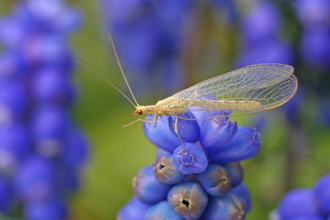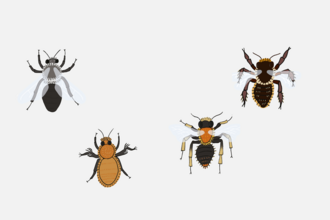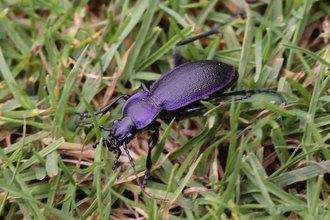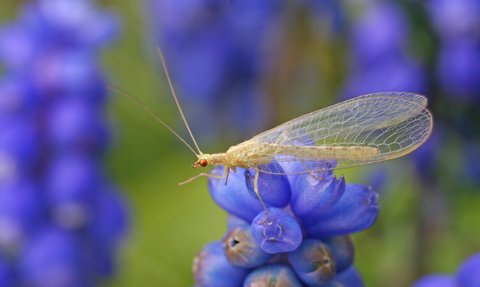
Common Green Lacewing ©Rachel Scopes
Insect-friendly gardening
Why are garden insects important?
Insects can be the organic grower’s best friend. Whether pollinators or predators, they will help manage unwanted garden visitors and keep your garden healthy. Here are seven of our favourite helpers and the plants they love! Don’t forget to check out our insect-friendly planting guide at the bottom of this page with more information on best types to plant at certain times of year.
Richard Burkmar
Hoverflies (Dipteria)
Often confused with wasps due to their similar yellow and black colouring. However, unlike wasps, hoverflies do not sting (nor do they have long antennae or a bulgy abdomen with a wasp waist, which can help you tell the difference). The adult hoverfly feeds on nectar and pollen, and their larvae are voracious predators of aphids and other garden pests. As a result, hoverflies should be welcome in any organic growing area, acting both as pollinators and pest controllers. How do you tell the sex of a hoverfly? It’s all in the eyes - the male's eyes meet at the top of the head, whereas the female's are separated by a gap.
Plants to attract hoverflies: yarrow, alyssum, dill, cosmos, mallow, poached egg plant, lemon balm, potentilla, marigold
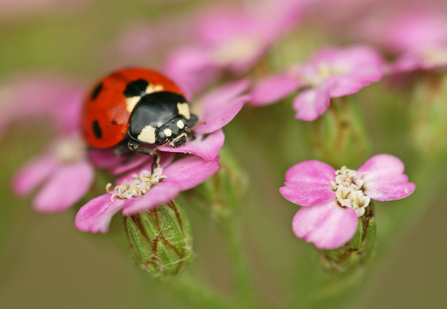
7-spot Ladybird ©Rachel Scopes
Ladybirds (Coleoptera)
These beetles are carnivores, feeding almost exclusively on aphids (green and black fly) and red spider mites. A great friend of the organic grower! Ladybirds lay hundreds of eggs in the colonies of aphids and other plant-eating pests. When they hatch, the ladybird larvae will eat up to 5,000 aphids. A ladybird can live up to three years. Its distinctive shell is often red or orange, and the number of spots can vary from two to 18.
Plants to attract ladybirds: yarrow, carpet bugleweed (Ajuga reptans), alyssum, penstemon, fennel, cinquefoil and tansy

Ed Marshall
Parasitic wasps (Hymenoptera)
These wasps do not sting. They lay their eggs on or in other insects. Although their life cycle is gruesome - after the egg hatches, the parasitoid larva eats the host alive before emerging as an adult - these insects have an important role to play in killing unwanted garden visitors, from brassica-munching caterpillars to sawflies, ants and aphids. They are produced on an industrial scale for release in fields and greenhouses!
Plants to attract parasitic wasps: yarrow, dill, mallow, cosmos, lobelia, alyssum, cinquefoil, marigold
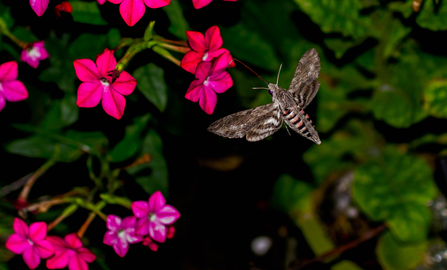
Convolvulus hawk-moth ©Jamie Mogridge-Percy
Butterflies and moths (Lepidoptera)
There are 2,500 species of Lepidoptera in Britain. Butterflies are usually brightly coloured day-flying insects, have clubbed antennae and hold their wings vertically above the body at rest. Most moths are nocturnal, hold their wings flat at rest and have either hair-like or feathery antennae. Butterflies drink nectar from flowers through their tongues, which function like straws. As well as being pollinators, and visually attractive in the garden, moths and butterflies are an important element of the food chain, as prey for birds, bats and other insectivorous animals (like blue tits who eat an estimated 50 billion moth caterpillars each year across Britain and Ireland!).
Plants to attract butterflies: buddleia, marjoram, lavendar, perennial wallflower
Plants to attract moths: jasmine, evening primrose, honeysuckle, sweet rocket and night scented stock
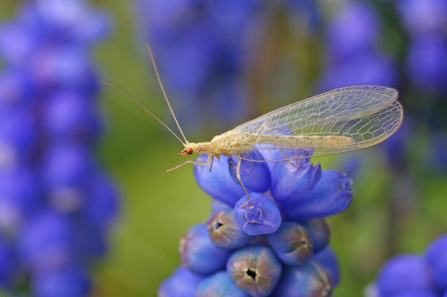
Common Green Lacewing ©Rachel Scopes
Lacewings (Neuroptera)
These beautiful insects are easy to recognise by their transparent lace-like wings, which are nearly twice as long as the abdomen. Both the adult and larvae are voracious consumers of aphids and insect eggs. The larvae have specialised mouthparts with large jaws that interlock to form pincers. Once impaled on these pincers, a prey's body contents are sucked out through hollow food channels running between the jaws.
Lacewings court by 'tremulation', a low frequency sound produced by both males and females vibrating their abdomens. This duet causes the surface they are standing on to vibrate. These courtship ‘songs’ differentiate lacewing species.
Plants to attract lacewings: yarrow, dill, angelica, coriander, cosmos, fennel and dandelion
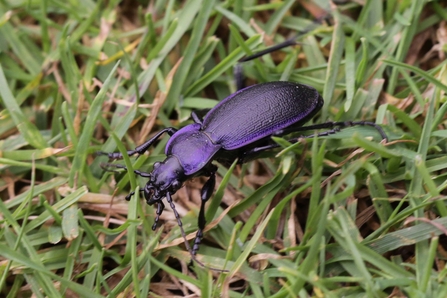
Violet ground beetle (Carabus problematicus) ©Margaret Holland
Ground beetle (Coleoptera, Carabidae)
The organic gardeners best friend! Ground beetles love slugs and snails. They eat by vomiting on their prey and waiting for their digestive enzymes to make their food more fluid and easier to eat. As the name suggests, many ground beetles spend their time on the ground and few can fly. So when you put down your slug beer traps, make sure there is a lip to prevent the poor beetle climbing in and drowning. Many ground beetles are nocturnal and need some form of shade during the day, such as a log pile, leaf litter or large stones. When threatened, ground beetles discharge a noxious, highly irritant fluid (harmless to humans) from the tip of their abdomen. Females also use this as their own can of 'pepper spray' to deter over-amorous males.

Nick Upton/2020VISION
Solitary bees (Hymenoptera)
Unlike honeybees, the solitary bee lives up to its name and does not live in colonies. There are more than 200 species of solitary bee in Britain, including the mason bee, which makes its nest in hollow reeds or holes bored in wood. (You can make your own bee 'hotel' with small hollow stems and twigs bound together.) Some solitary bees look like honeybees, and although they carry pollen on their legs, unlike honey bees, they don't have pollen baskets on their hind legs. The female will dig the nest, stock it with nectar and pollen and then seal it, leaving the young to fend for themselves. Some build nests in the ground, although others build aerial nests, usually in bramble stems, or in empty snail shells, sealing the entrance with chewed leaves and saliva. Then there are the leaf-cutter bees, which cut neat circles out of rose leaves and petals, and nest in dead plant stems or sometimes in stacks of old flowerpots. All solitary bees are excellent pollinators and should be encouraged into your garden.
Plants to attract solitary bees: lavender, fuschia, heather, viburnum, marjoram, cat mint

A hornet mimic hoverfly © Joan Burkmar
Planting guide for an insect-friendly garden
Read the above and ready to take action? Use this handy guide to the perfect plants to attract insects to your garden. We've choosen plants that'll mean you have flowers in bloom all most all year round!

